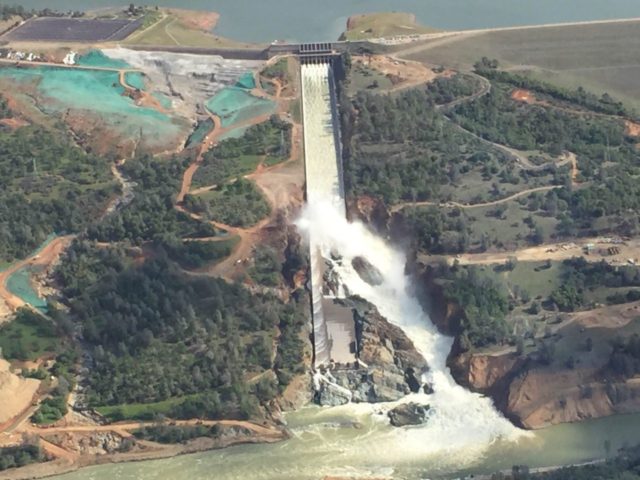Oroville Dam and its infamous spillway that failed and threatened 200,000 Californian lives passed its 2014 regulatory “failure mode and effects analysis” with top safety ratings.
Popular Mechanics last year rated California’s Oroville Dam as the ‘Most Serious Dam in the United States’ because the 770 feet tall and three-quarters of a mile wide earthen dam had stood as America’s tallest dam for 50 years. As a key anchor in America’s water infrastructure system, Oroville Dam received a 50-year non-federal hydroelectric development license in 1957 from the Federal Energy Regulatory Commission (FERC).
But despite Oroville Dam failing to get a 50-year extension by January 31, 2007 and operating on one-year temporary regulatory extensions for the next decade due to safety concerns, the Department of Water Resources (DWR) Division of Operation and Maintenance produced “Failure Mode and Effects Analysis” in 2014 that made 7 top safety claims of “highly unlikely” for the risks of dam or spillway failure.
The most egregious failure mode analysis error was California DWR officials’ response to concerns that upstream flooding could cause massive amounts of water to flow into the dam’s reservoir and threaten the dam in a very wet winter: “Could possibly over top Oroville if all upstream dams fail during one event, but this is “highly unlikely” and not to be considered further.”
Breitbart News reported that UC Berkeley’s Center for Catastrophic Risk Management’s recent multi-UC-campus forensic analysis titled “Root Causes of the Oroville Gated Spillway Failures and Other Developments,” blamed the DWR for failing to address the dam’s known persistent leaks and wet spots; the spillway’s known cracks and patchwork repairs; and the known cracked water gate and broken anchor tendons.
It is unknown at this time why California did not fund repairs to address known risks, but DWR’s 2007 application for a 50-year FERC license extension included commitments to fund a stakeholder’s $1 billion ‘Settlement Agreement’ that obligated the dam to fund $454 million for environmental issues, $438 for recreation issues, $77 million for cultural resources, $62 million for additional enhancements, and $7 for land aesthetics.
The California DWR produced a cheery 17-page full-color marketing brochure titled: Highlights of the Settlement Agreement for Licensing that did not detail the names of the “stakeholder” recipients or what specific items would be funded.
But the much more difficult to find 413-page ‘Supporting Technical Information Document’ for the 2007 FERC 50-year extension reveals that most of the $458 million “environmental” money went to fish, birds and the red-legged frogs; a big piece of the $62 million “enhancements” went to highly-politicized interest groups including Citizens for Fair and Equitable Recreation, American Whitewater, Feather River Low Flow Alliance, International Mountain Bicyclists, and Chico Paddleheads; and “$77 million for cultural resources went to the Kon Kow Valley Band of Maidu Native Americans.
There was no mention in the 2014 “failure mode and effects analysis” about any major updates or new dam or spillway infrastructure improvements at Oroville Dam. The DWR analysis acknowledged a large number of leaks and cracks, but claimed all the issues were repaired as part of normal maintenance.
It is believed that the State of California paid about $200 million during the Oroville Dam February to May crisis, and then awarded a $275.4 million contract to Kiewit Construction Company to repair the dam’s main spillway in an all-out effort to stabilize Oroville Dam before the rainy season is expected to begin in October. The full cost is unknown, but Breitbart’s local sources believe the full-cost is much larger.

COMMENTS
Please let us know if you're having issues with commenting.